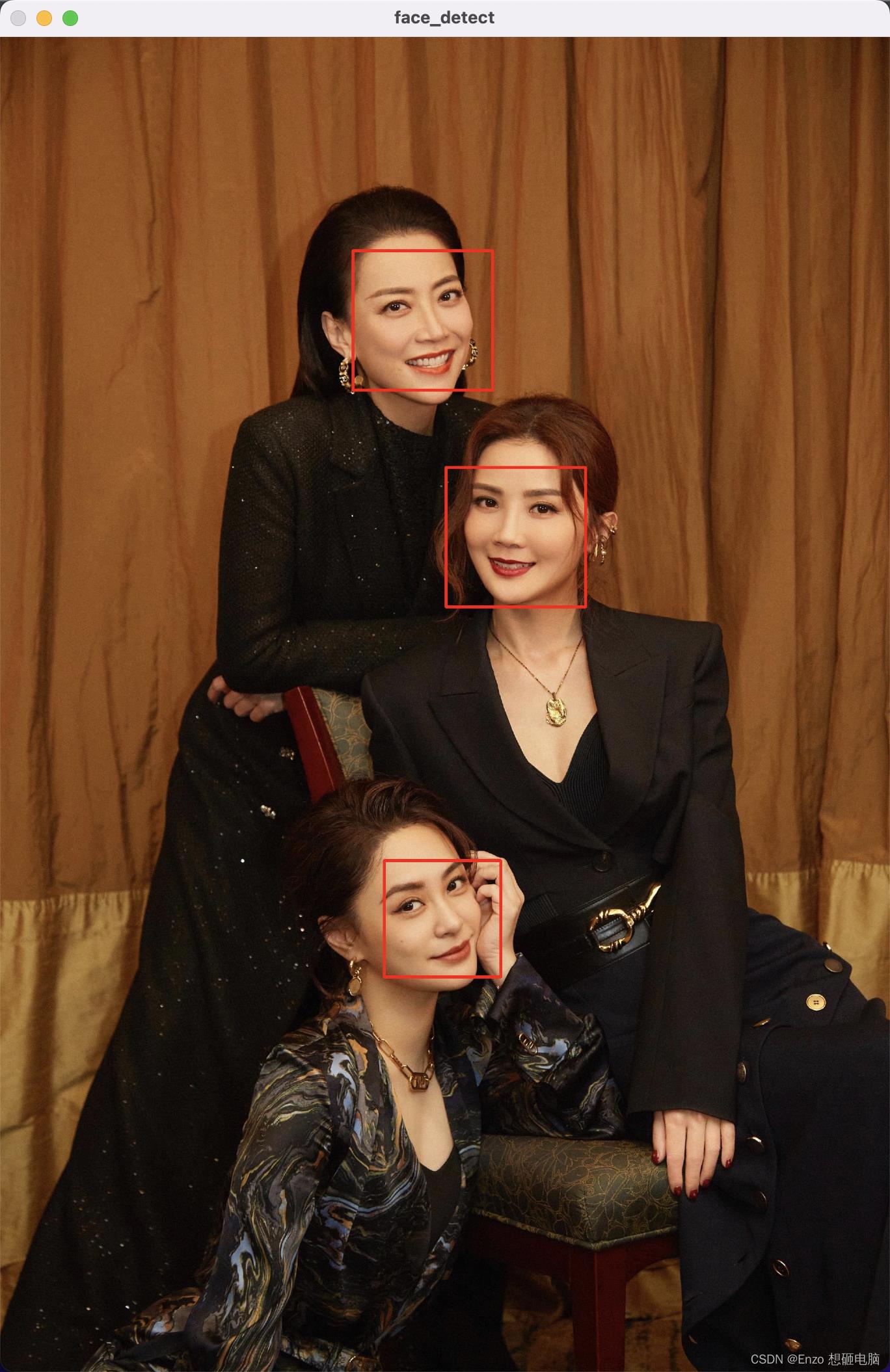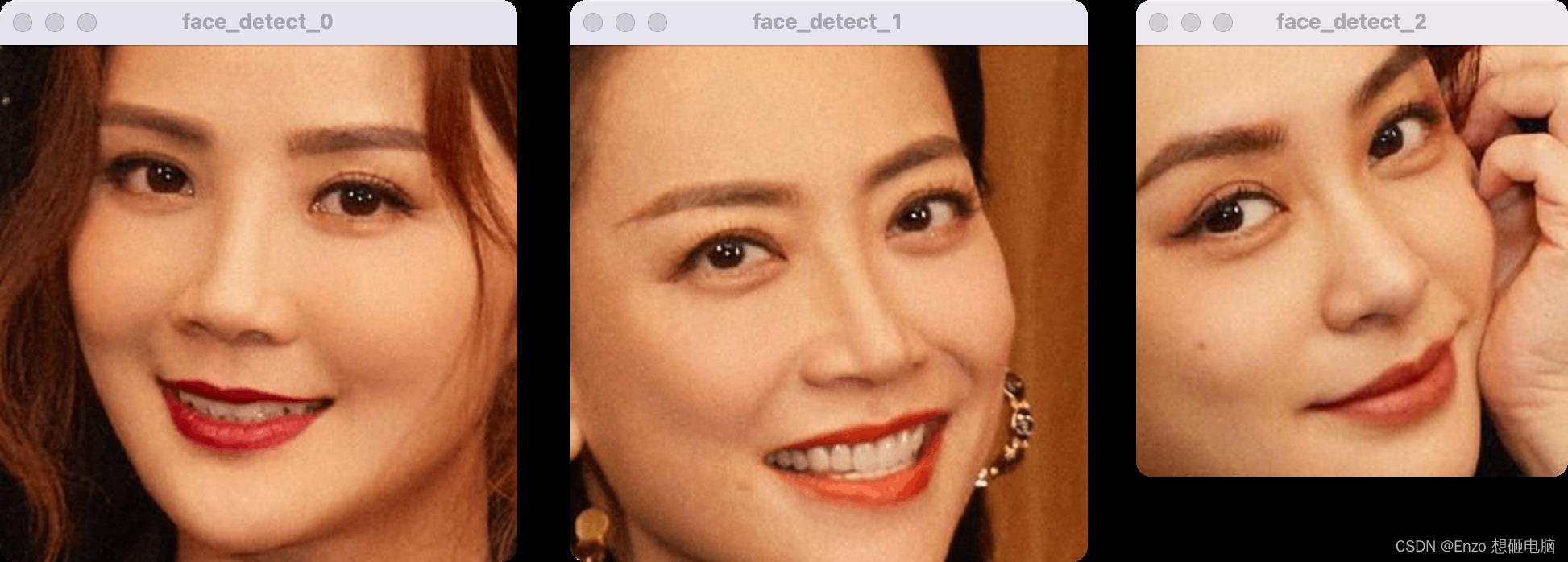人脸识别face_recognition 库的使用
Posted Enzo 想砸电脑
tags:
篇首语:本文由小常识网(cha138.com)小编为大家整理,主要介绍了人脸识别face_recognition 库的使用相关的知识,希望对你有一定的参考价值。
目录
1. load_image_file 加载图像
- 输出图像是 RGB 格式(opencv中是 BGR 格式)
- 图像类型是 ndarray
import face_recognition
image = face_recognition.load_image_file("image.jpeg") # 读取图像
print(image.shape) # (3073, 2048, 3)
print(type(image)) # <class 'numpy.ndarray'>
2. face_locations 定位图中所有人脸
函数作用:识别出图像中所有人脸,并以列表的形式返回人脸的位置信息
函数输出:输出一个列表,形如: [(411, 956, 540, 827), (283, 605, 390, 497)]
- 列表中包含两个tuple (411, 956, 540, 827) 和 (283, 605, 390, 497) ,表示识别出了两个人脸
- 每个 tuple 中的4个数字表示这个人脸的位置信息,分别为 [top, right, bottm,left] , 代表框住人脸的矩形中左上角位置坐标 (left, top)和右下角的位置坐标(right, bottom)
import face_recognition
import cv2
image = face_recognition.load_image_file("image.jpeg") # 读取图像
face_locations = face_recognition.face_locations(image) # 获取人脸位置
print(face_locations)
输出:
[(990, 1347, 1311, 1026), (491, 1133, 812, 812), (1895, 1152, 2163, 884)]
检测到的第一个人脸位置坐标(990, 1347, 1311, 1026),对应如下

(1)在原图像中框出人脸
import face_recognition
import cv2
image = face_recognition.load_image_file("image.jpeg") # 读取图像
face_locations = face_recognition.face_locations(image) # 获取人脸位置
print(face_locations)
# ---------------------------------------------------
img = cv2.cvtColor(image, cv2.COLOR_RGB2BGR)
for p in face_locations:
print(p)
face_detect = cv2.rectangle(img, (p[3], p[0]), (p[1], p[2]), (0, 0, 255), 5)
cv2.imshow('face_detect'.format(), face_detect)
cv2.waitKey()
cv2.destroyAllWindows()

(2)剪切出人脸
import face_recognition
import cv2
image = face_recognition.load_image_file("image.jpeg") # 读取图像
face_locations = face_recognition.face_locations(image) # 获取人脸位置
print(face_locations) # [(411, 956, 540, 827), (283, 605, 390, 497)]
img = cv2.cvtColor(image, cv2.COLOR_RGB2BGR)
for i, p in enumerate(face_locations):
face_detect = img[p[0]:p[2], p[3]:p[1]]
cv2.imshow('face_detect_'.format(i), face_detect)
cv2.waitKey()
cv2.destroyAllWindows()

3. face_landmarks 识别人脸关键点
- 函数作用:识别出 9种人脸关键点信息 ,包括眼睛、鼻子、嘴巴和下巴等
- 返回值:是个list,列表长度表示有几个人的面部信息;list 中的项是字典,每个字典的key表示面部特征的名字,值为这个面部特征的位置信息(是一个列表); 特征点包括:
- nose_bridge
- right_eyebrow
- right_eye
- chine
- left_eyebrow
- bottom_lip
- nose_tip
- top_lip
- left_eye
import face_recognition
import cv2
import numpy as np
image = face_recognition.load_image_file("image.jpeg") # 读取图像
face_landmarks_list = face_recognition.face_landmarks(image) # 获取人脸位置
img = cv2.cvtColor(image, cv2.COLOR_RGB2BGR)
for face_landmarks in face_landmarks_list:
facial_features = [
'left_eye',
'right_eye',
'nose_tip',
'top_lip',
'bottom_lip'
]
# 在图像中画出每个人的眼睛, 鼻子, 嘴巴!
for facial_feature in facial_features:
points = np.array(face_landmarks[facial_feature])
cv2.polylines(img, [points], False, (0, 0, 255), 2)
cv2.imshow('facial_feature', img)
cv2.waitKey()
cv2.destroyAllWindows()

以上是关于人脸识别face_recognition 库的使用的主要内容,如果未能解决你的问题,请参考以下文章
山东大学项目实训四——Face_Recognition 使用Opencv和Dlib实现基于视频的人脸识别
Python 使用 face_recognition 人脸识别
[深度学习] Python人脸识别库face_recognition使用教程